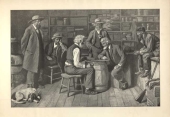The Checker Maven
The World's Most Widely Read Checkers and Draughts Publication
Bob Newell, Editor-in-Chief
Published each Saturday morning in Honolulu, Hawai`i
Contests in Progress:
Sixth Position

Yes, there is in fact a Sixth Position in classical ballet, going literally a step beyond the five positions known to the typical neophyte ballet student, and it's being demonstrated by our ballerina in the photo above.
In a previous Checker School installment about Second Position, we made a similar analogy to dance arts, and in making a like analogy with Sixth Position, we are just as certain as we were in our earlier installment that both ballet's standard positions and checkers' standard positions are quite unfamiliar (to say the least) to the general public.
But we would certainly never dare to lump in our loyal Checker Maven readers with the general public, so we are sure that many of you have at least some familiarity with the Sixth Position of checkers; and today, we challenge you to either demonstrate your mastery, review or relearn an old lesson, or gain new checker knowledge, all depending upon where you currently stand on the scale of checker erudition.
Here, then, is the classic Sixth Position.
A. MACKINTOSH
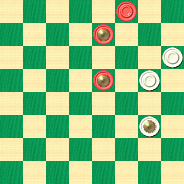
Black Plays, White Draws
B:W12,16,K24:B3,K7,K15.
Demonstrate how it's done, and when you've finished, click on Read More for the solution, sample games, and detailed notes.![]()
Head's Redeemer
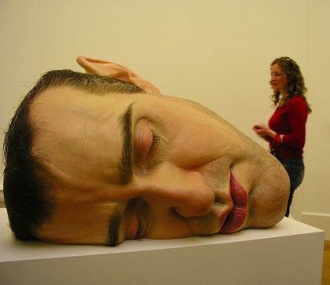
It seems that Mr. Lucius S. Head (whose visage, by the way, is certainly not shown in the picture above) is better known to us than to Mr. Ryan, as we know that he (Mr. Head) was once a resident of Chicago and played many games with old-time Windy City checker expert and somewhat controversial author John T. Denvir. Mr. Head also resided at one time in Minneapolis, Minnesota, and was Minnesota state champion. But such details notwithstanding, in this month's installment from Willie Ryan's Tricks Traps & Shots of the Checkerboard, we see an interesting and practical situation which Mr. Ryan attributes to Mr. Head. Here's Willie to tell us more.

"L. S. Head, of Albany, New York, American member of the 1905 International Checker Team, was a modest soul whose name rarely appeared in checker periodicals of his day. Yet he was a distinguished and widely respected player, as well as an accomplished analyst. Among the few notable items credited to his name is the practical position treated here, known as "Head's Draw," which keeps popping up in play every now and then.
| 10-15 | 6-10 | 1-5*---1 |
| 23-18 | 25-22 | 22-17 |
| 11-16 | 9-14 | 5-9*---2 |
| 18-11 | 18-9 | 17-13 |
| 8-15 | 5-14 | 15-18* |
| 22-18 | 27-23 | 13-6 |
| 15-22 | 8-11 | 2-9 |
| 25-18 | 19-16 | 30-25 |
| 16-20 | 12-19 | 9-13 |
| 29-25 | 23-16 | 26-22---A |
| 4-8 | 11-15 | 10-15 |
| 24-19 | 32-27 | 28-24 |
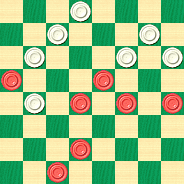
BLACK
Black to Play and Draw
B:W31,27,25,24,22,21,16:B20,18,15,14,13,7,3.
A---If 26-23, 10-15 are played, 23-19 insures a draw; but if 28-24 is used, black shoots the works with: 15-19, 24-15, 20-24, 27-20, 18-27, 31-24, 7-11, and black wins by capturing the piece on 25."
1---Despite the star here, KingsRow gives 1-6 to draw as well---Ed.
2---Again despite the star, KingsRow gives 15-18 to draw also---Ed.
Can you use your head and solve this one? Noodle on it for a while then head over to the solution by clicking on Read More.![]()
Grant vs. M'Guire
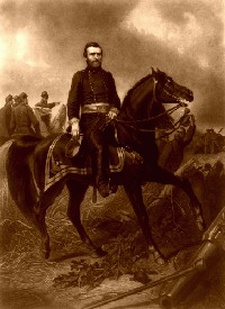
General Ulysses S. Grant
Everyone knows about the great American general Ulysses S. Grant, who fought on the side of the Union in the American Civil War. However, we can find no record of a Confederate general named M'Guire or McGuire. The only reference our research department was able to uncover was of a physician, Dr. Hunter Holmes McGuire, who served with the Confederate army and who was in fact present at the famed Battle of Gettysburg. However we can't find any indication that Dr. McGuire's unit ever faced any of General Grant's units in combat, and we're even more certain that they never met in person over the checkerboard. General Grant went on to be President of the United States, and Dr. McGuire went on to become a contributor to the first of the Geneva Conventions.

Dr. Hunter Holmes McGuire
Today's Checker School position, which is taken from an actual game between someone named Grant and someone named M'Guire, certainly didn't involve the two Civil War personages mentioned above; and the game actually took place in 1893, some 28 years after the end of the War Between the States. It's a small "set piece" battle which is of considerable practical interest.
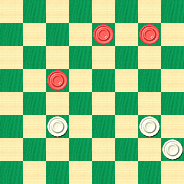
WHITE
Black to Play, White to Draw
B:W22,24,28:B7,8,14.
Can you align the troops such that the Black and White armies fight to a draw? Sound the bugles and beat the drums, then work out the solution before clicking on Read More to charge over to the solution, a sample game, and notes.![]()
Strickland's Draw

We return to Willie Ryan's popular classic, Tricks Traps & Shots of the Checkerboard for today's column. In this installment, we find the Black forces in a real predicament, needing, it seems, to draw a pair of aces. But Willie shows us how to beat the odds, as he explains in his own words below.

"Another distinguished member in the checker Hall of Fame is William Strickland, who, with Willie Gardner, of Leeds, England, was among the first to introduce the art of playing checkers blindfolded. Like Dunne, Shearer, and other luminaries of his day, Strickland was a prolific analyst and scholar, discovering many of the standard positions that today are known to all advanced players. Here we present the important Strickland Draw, which can arise from almost every opening on the board.
| 9-14 | 22-17 | 3-8 |
| 22-17 | 8-11 | 30-26 |
| 11-16 | 29-25 | 8-11 |
| 25-22 | 11-15---A | 26-23 |
| 8-11 | 25-22 | 5-9 |
| 17-13 | 15-24 | 32-28 |
| 11-15 | 27-11 | 11-15 |
| 24-19 | 7-16 | 31-26 |
| 15-24 | 23-19 | 15-24 |
| 28-19 | 16-23 | 28-19 |
| 4-8 | 26-19 |
arriving at the diagram.
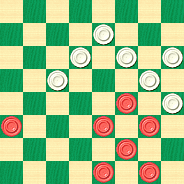
BLACK
Black to Play and Draw
B:W26,23,22,21,19,17,13:B14,12,10,9,6,2,1.
A---If 16-20 is played, proceed with 19-16, 12-19, 12-19, 23-16, 11-15, 26-23, 15-19, 30-26, 10-15, 17-10, 7-14, 16-11, 19-24, 13-9, 6-13; at this point 25-22 insures the draw, but if 32-28 is employed, black hits the jackpot with 15-18, 28-19, 14-17, 21-14, 5-9, 14-5, 3-7, 23-14, 7-30."
Can you turn up the card that saves the day? Don't be skunked; solve the problem and click on Read More to shuffle over to the solution.![]()
In the Hedges

Today's class in our monthly Checker School series is nearly a miniature, having but three men per side; and, as usual for a Checker School entry, it's eminently practical. Our title is taken from Thomas A. Hedges, who reportedly first solved the problem when it was published well over 100 years ago. Today, it remains a good position to know for the cross-board player.
BLACK
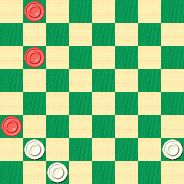
WHITE
White to Play and Win
W:W25,28,30:B1,9,21.
White has an advantage that can't be easily described as very large, but still, it's enough to win. Can you find your way out of the thicket, or will you be scratched by brambles? Have no fear of monsters lurking in the maze; clicking on Read More will rescue you at once and bring you to the solution, a sample game, and detailed notes.![]()
Shearer's Cleaver
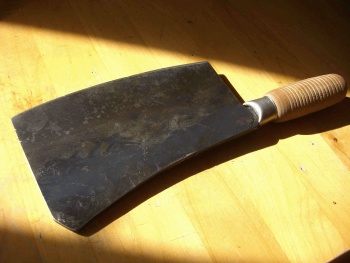
This week we return to our popular series taken from Willie Ryan's Tricks Traps & Shots of the Checkerboard, a true all-time classic of checker literature. We feature a setting called Shearer's Cleaver in which Willie shows us how, after a misstep by the Black side, White mercilessly chops him down. Let's let Willie narrate the tale.

"The masters often get into spirited controversies over who was first to show a particular line of play or shot. This Bristol Cross trap is a case in point. D. G. McKelvie, of London, England, claimed he was first to show it, but H. F. Shearer, of Scotland, published it first in 1892 and received credit for it. If an analyst has in mind a certain new play or analysis, but does not publish it, he has no legal claim of authorship or priority to it. It has been demonstrated time and again that champions often independently discover the same play and 'cooks,' but wishing to use these discoveries in future matches and tournaments, they keep their play under cover. More than one champion has yelled 'foul' when another has published a play or received credit for an analysis that he thought nobody else knew!
This is the way you start:
| 11-16 | 7-10 | 5-14 |
| 23-18 | 22-17 | 29-25 |
| 16-20 | 9-13 | 3- 7 |
| 24-19 | 27-23---A | 31-27 |
| 10-14 | 13-22 | 7-11---B. |
| 18-15 | 25- 9 | See the |
| diagram. |
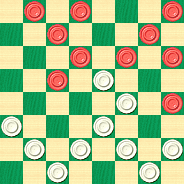
WHITE
White to Play and Win
W:W32,30,28,27,26,25,23,21,19,15:B20,14,12,11,10,8,6,4,2,1.
A---An alternate trap can be set here by 26-22. Now 5-9, 30-26, 2-7, 27-23, 7-11, 32-27, etc., will end in a draw; but if after 26-22 at A, black replies with 2-7, white explodes with: 19-16, 12-19, 27-24, 20-27, 32-16, 10-19, 17-10, 7-14, 22-17, 13-22, 25-2, and white wins. H. F. Shearer.
B---Starts the stroke. Black's only draw move is: 1-5*, 25-22, 20-24*, 27-20, 7-11, 22-17 (not 22-18, 6-9, 15-6, 11-16, 20-11, 8-31, black wins), 11-27, 32-23, 6-9, 17-13, 10-15, 19-10, 14-17, 13-6, 2-9, 21-14, 9-27. D. G. McKelvie vs. James Searight."
Can you find the winning method, or will this problem take a slice out of you? Take a cut at it, and when you've hacked out the answer, click on Read More for the sharp and incisive solution.![]()
Always Drink Water

The primary offices of The Checker Maven are, as we've noted from time to time, in Santa Fe, New Mexico, in the American Southwest. Santa Fe can be described as "high desert" as it lies over 7,000 feet above sea level and the climate is rather dry. It's a place where the altitude and the dryness combine to make dehydration a real issue. Tourists often complain of headaches, not realizing that they need to drink a lot of water to replace water loss silently taking place at a rate to which they are not accustomed.
Today, in our monthly Checker School column, we are asking you to "drink water" in a different manner. The topic of our lesson is Drinkwater's Draw, attributed unsurprisingly to old-time checkerist F. W. Drinkwater. It's another of those eminently practical maneuvers that will save you many a game--- if you know how. Here's the basic position.
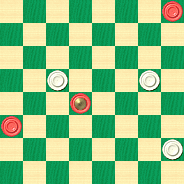
WHITE
White to Play and Draw
W:W14,16,28:B4,K18,21.
Black is clearly in the lead here, having a King and two men to White's three men, and one of the White men is under attack. Would you be able to save this one?
Give it a try, but if it's too much to swallow, click on Read More to drink in the solution, a sample game, and copious notes.![]()
Tommy Meets Marvin

It was a Saturday morning in the Florida fall, and as was usually the case, Tommy had rushed over to Uncle Ben's porch for his weekly checker lesson. Of course as you know by now, Uncle Ben wasn't really his uncle, but calling the kindly old gentleman "Uncle Ben" just seemed like the right sort of thing to do.
"So, Tommy, you must tell me all about it!" exclaimed Uncle Ben from his comfortable seat on the porch's outdoor sofa.

Tommy Wagner
Tommy couldn't wait to tell Uncle Ben his news--- Tommy had met professional checker star Marvin J. Mavin in person, and had played against him in a simultaneous exhibition at Tommy's grade school!
Marvin J. Mavin, as our regular readers are aware, is the team captain of the Detroit Doublejumpers, in the American Conference of the National Checker League. Marvin is well-known for his work in schools with the up-and-coming checkerists of the next generation. Marvin is also known as being, shall we say, somewhat of a character.
"Yes, Uncle Ben, I got to play in the simul against Marvin!" said Tommy excitedly. "First he gave a lecture to all the students and then workshops for our teams and ..."
"Whoa, slow down a bit, Tommy!" asked Uncle Ben. "That's rather a lot at once! Tell me first, what kind of impression did Marvin make on you?"

Marvin J. Mavin
"Well," replied Tommy, "he knew everything about checkers and there wasn't any question he couldn't answer! I'd sure like to be a great checker player like Marvin some day, although...." Here Tommy hesitated a little.
"Go on, Tommy," urged Uncle Ben.
"It's just that his hair looked like he ought to maybe, you know, wash it? And he did kind of smell a little like beer..."
"Ah yes," said Uncle Ben, "in my own professional playing days, we took a little more care with our image and the impression we made. Marvin is a fine checker player, but you'd be best advised not to imitate some of his, shall we say, less desirable characteristics. But enough of that; it's great that you got to play in the simul, so tell me about it."
"I got to play because I'm Captain of the Junior Varsity this year," said Tommy, "and that gave me a table at the simul. Would you care to go over the game with me?"
"Of course, Tommy," said Uncle Ben. "I imagine Marvin won? It would be tough even to get a draw against a seasoned professional."
"He did win," said Tommy, "and I don't feel bad about that at all. I was just happy to have a chance to play. Still, at one point I thought I might have gotten a draw. Here's how the game went."
11-15, 22-18, 15-22, 25-18, 12-16, 29-25, 9-13, 26-22, 16-20, 24-19, 5-9, 21-17, 8-12, 25-21, 4-8, 30-26, 1-5, 28-24, 8-11, 32-28, 11-16, 19-15, 10-19, 24-15, 16-19, 23-16, 12-19, 27-24, 20-27, 31-24, 7-10, 17-14, 10-17, 21-14, 2-7, 15-11, 7-16, 24-15, 3-7, 26-23, 16-20, 23-19, 20-24, 15-10, 6-15, 19-3, 24-27, 14-10, 9-14, 18-9, 5-14 (diagram)
"Look at this, Uncle Ben!" Tommy went on. "I had lost a man, but I thought that it still wasn't so easy for Mr. Mavin to win. But he played this great series of moves..."
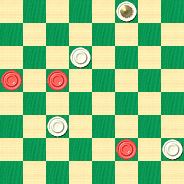
WHITE
White to Play and Win
W:B13,14,27:W28,22,10,K3.
"That's what makes him a top player," said Uncle Ben, "not missing an opportunity to bring home the win. But this is a familiar theme that is worthy of further study. Do you know where you went wrong, and do you understand now how Marvin was able to win?"
"Yes, sir, I do," said Tommy. "I know which was my losing move, and here's how Mr. Mavin got the win."
Are you as good as Marvin J. Mavin, and can you find the winning moves in the position shown below? Can you find and correct Tommy's losing move?
Give it some study, and when you've come up with your answer, click on Read More for the solution, a large selection of additional examples of this theme, and the conclusion to this week's story.![]()
Workman's Whizzbang

The workman shown above has a real whizzbang of a job ahead of him in restoring what's left of that automobile; but in this month's installment from Wille Ryan's Tricks Traps & Shots of the Checkerboard, we'll look at a whizzbang of a much different kind, attributed to a checker workman eponymously named Workman. Willie will tell us all about it.

"Take a really good look at this classic crossboard skirmish between Champion Herman L. Rudolph, of Pittsburgh, Pennsylvania, and E. E. Workman (former champion of Virginia), of Washington, D. C. It was played at the 1948 Cedar Point (Ohio) Master's Tourney, and shows how the benign gentleman from Virginia unexpectedly floored hard-hitting Herman with a bristling double-action flourish. Play:
| 10-15 | 22-18---A | 11-15---B |
| 24-20 | 15-22 | 20-16 |
| 15-19 | 25-18 | 8-12 |
| 23-16 | 8-11 | 30-26---4 |
| 12-19 | 17-13 | 6-10---D |
| 27-24 | 3-8 | 27-23 |
| 7-10 | 26-22 | 1-6---E |
| 24-15 | 9-14 | 29-25 |
| 10-19 | 18-9 | 14-17---F, |
| 21-17 | 5-14 | forming the |
| 11-15 | 32-27---2 | diagram. |
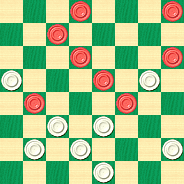
WHITE
White to Play and Win
W:W13,16,22,23,25,26,28,31:B2,4,6,10,12,15,17,19.
A---A distinctive departure from all orthodox play---1, but quite sound.
B---Splendidly played by black to here. The following is much stronger, but results in a draw only: 11-16, 20-11, 8-15, 29-25, 4-8, 27-24*, 1-5---C, 25-21, 14-18, 22-17, 18-22, 17-14*, 6-9, 13-6, 2-18, 21-17, 19-23, 24-19, 15-24, 28-19, etc. Wm. F. Ryan.
C---If 8-11 is moved, 22-18 will produce a draw at once; if 6-10 is used, then 25-21, 2-6, 22-17, 8-12, 30-25, will do it easily---3.
D---Against 14-17, white replies 27-24, 6-10* (17-21, 16-11, 21-25---5, 11-8, 4-11, 22-18, and white wins) and 13-9 catches the draw easily. If instead of 13-9 white takes the shot by 22-18, black scores this brilliant win based on a problem gem by Dr. Brown: 22-18, 15-22, 24-6, 12-19, 31-27!, 22-31, 27-24, 1-10, 24-6, 2-9, 13-6, 17-21*, 28-24, 4-8*, 24-20, 8-12*, 6-2, 31-26, 2-6, 26-22, 6-10, 22-18, 10-6, 18-15, 6-9, 15-11, 9-14, 12-16, 14-18, 16-19, 18-22, 19-23*, 22-18, 23-27, 18-23, 27-32, 23-19, 32-28*, 19-16, 11-15*, 16-12, 28-24, 12-16, 15-18*, 16-12, 24-19, 20-16, 18-14, 16-11, 14-10, 11-8, 10-7, 8-4, 7-3, 4-8, 19-15. The play in this note proves that there are losing shots as well as winning ones.
E---Against 14-17, white must play carefully to draw: 14-17, 23-18, 17-21,18-11, 21-25, 31-27*, 25-30 (nothing better)---6, 26-23, 19-26, 27-24, etc.
F---Asleep at the switch! Seemingly deceived by the blase appearance of the situation, Rudolph innocently walks into Workman's deadly trap. Of course, 14-18---7, 23-7, 2-20, 25-21, 6-10, would have nailed a draw."
1---32-27 is a good move here; with the text move, Black starts to get a small edge---Ed.
2---At this point, KingsRow thinks Black has a recognizable advantage, though certainly short of winning---Ed.
3---KingsRow actually prefers a move Willie didn't give, 8-12, in this position, for instance 8-12 25-21 14-18 22-17 19-23 24-20 18-22 17-14 22-25 21-17 25-29 and Black probably should be able to win---Ed.
4---16-11 would have been a likely draw here according to KingsRow---Ed.
5---Here 16-11 would be better but still is a probable loss----Ed.
6---Actually KingsRows finds 1-6 to be substantially better and likely winning! For instance, one continuation is 1-6 17-22 25-30 26-22 30-25 22-18 25-22 18-14 19-23 14-7 23-32 7-3 12-19 17-14 22-18 14-9 18-14 9-5 14-10 29-25 6-9 13-6 10-1 25-22 19-23 3-7 23-26 7-10 32-27 10-14 27-23 28-24 26-31 22-17 31-27 24-20 23-19 14-10 27-23 and the man on 11 can't be saved; Black Wins---Ed.
7---2-7 also draws according to KingsRow---Ed.
Can you, in a workman-like fashion, reproduce the win that Mr. Workman found here? Do your work, and then make easy work of it by clicking on Read More to see how a real crafstman does it.![]()
Review Your Work

Music teachers point out the classic wisdom that one's technique in playing a musical instrument either improves or falls back; it never stays constant. We know this to be true as well of our skills in many human endeavors, be it business, the arts, or our game of checkers. Constant practice and study are required if we are to maintain our technique, let alone move it forward.
Today's lesson in our Checker School series provides us with an important opportunity to review our work. The position shown below should be familiar to most checkerists, and certainly so to regular readers of our weekly columns. We've seen this before, and more than once.
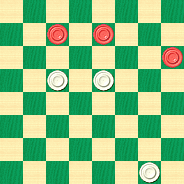
WHITE
White to Play and Win
W:W14,15,32:B6,7,12.
If you don't recall how to win this one, now's the time to brush up and review the method, as it's an eminently practical example, sure to arise in your own play. Think back and see if you can solve it; then click on Read More for the solution, notes, and sample games.![]()
The Checker Maven is produced at editorial offices in Honolulu, Hawai`i, as a completely non-commercial public service from which no profit is obtained or sought. Original material is Copyright © 2004-2025 Avi Gobbler Publishing. Other material is the property of the respective owners. Information presented on this site is offered as-is, at no cost, and bears no express or implied warranty as to accuracy or usability. You agree that you use such information entirely at your own risk. No liabilities of any kind under any legal theory whatsoever are accepted. The Checker Maven is dedicated to the memory of Mr. Bob Newell, Sr.

